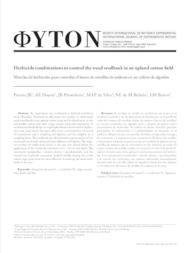Herbicide combinations to control the weed seedbank in an upland cotton field.
Herbicide combinations to control the weed seedbank in an upland cotton field.
Author(s): PEREIRA, J. R.; DUARTE, A. E.; PITOMBEIRA, J. B.; SILVA, M. A. P.; BELTRAO, N. E. de M.; BARROS, L. M.
Summary: An experiment was conducted in dryland conditions of the Brazilian Northeast to determine the number of viable weed seeds (seedbank) in an upland cotton crop, and its distribution in the soil profile, before and after using various herbicide treatments. A randomized block design in a split-plot block scheme with 6 replications was used, where the main plots were constituted by a factorial (13 treatments and 2 sampling soil depths), and the subplots by 2 sampling dates. The seedbank was determined by germination of the recovered weed seeds obtained from different soil depths. The highest number of viable weed seeds in the area was found before the application of the herbicide treatments at 0 - 10 cm soil depth. The treatments metalachlor + diuron; diuron + pendimethalin and the control (no herbicide treatment, weeded weekly during the entire cotton crop cycle) were the most effective in reducing the weed seedbank in the area.
Publication year: 2013
Types of publication: Journal article
Unit: Embrapa Cotton
Keywords: Herbicida
Observation
Some of Embrapa's publications are published as ePub files. To read them, use or download one of the following free software options to your computer or mobile device. Android: Google Play Books; IOS: iBooks; Windows and Linux: Calibre.
Access other publications
Access the Agricultural Research Database (BDPA) to consult Embrapa's full library collection and records.
Visit Embrapa Bookstore to purchase books and other publications sold by Embrapa.

